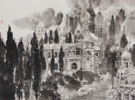为了更好地理解他的作品,我想要他摊开账单给我看:联合利华给了多少钱,来做这个项目;他的这些瓜子事后准备怎么卖?等等。
拿了基金会或赞助的钱做大作品,还是艺术品么?
我的回答是:N o,it isn‘t!做壮观,就更像艺术?不是。否则毛泽东的人民公社和文化大革命就该拿二次艺术诺贝尔奖了。
这是广告,是景观,是一只资本主义水獭的欲望循环装置。记得很小的时候父亲就向我指出哪些是水獭晚间的工作或作品,儿童大概都仇恨艺术,尤其受不了那么骄傲的水獭的作品,所以,我是天天去破坏它们,以此为乐,好象存心要与水獭对着干,好让它提高艺术水平似的。那条大陆资本主义小河上如今是寄生着很多的艺术家了,他们中最厉害的那条水獭看来是艾未未,他的装置做的比那条河还要大了。而我仍是那个恶作剧的儿童。应该如何对待这些矫揉造作的瓜子呢?我看是埋回地下都不行的了。它们足以让我们这个homo sacer们的全球资本主义的黄奴时代遗臭万年了;这仿佛是为可口乐可做了一亿顶宣传小红帽那样的壮举。独裁者利用中国人集体成为全球生产机器,来壮自己的权威,艺术家这么做是想要干什么?德波尔说:参观兵马俑的里根和撒切尔,是想狗尾续貂;那么,学着秦始皇来做俑瓜子的未未,是想续什么貂呢?
未未会想,是不是其实也可以这样来搞艺术:都你他妈大资本家的钱,我在解构和推翻你之前,是不是先可以顺势糟蹋你一下,让你掏出钱做最大想象极限的东西,做一些艺术品,壮一下中国当代艺术的威,象傅立叶想要十九世纪的人们从伦敦到印度一天打个来回那么漂亮地去想象。当然,艺术家只要划出一条草图就行,用不着真的去建喷气飞机。不过,用资本家的钱来做大景观,在如今就是替全球资本主义做技工了,为联合利华做活体广告了,艺术家应该比较忌讳这个。但是,这样的一个项目送上门来,这么多的赞助,你舍得拒绝么?艺术家可以先做了资本家和企业家,然后再做回艺术家,艾未未我想会这样自辩,就像风尘女子说,只要赚足了钱,或遇到一个真正的好男人,就一定洗手不干,至少也能做个杜十娘,我们应该相信他百分之几?
艺术家是那最终拒绝卖淫的人。卖淫给资本主义装置,是更色情的事儿。但是我关心川震的孩子,我反对专制那丫的呀,这样可以加分了吧?No,you cannot。艺术家不干这样的下流事儿的。艾未未们却在做这样NGO式的高级定制,却越做越红火了。联合利华越洋和跨国地打来的,是召妓电话吧?
阿波和未未我觉得就是在向西方资产阶级提供这样的高级定制式的一条龙服务,办公室都设在西方了。其创意内容足够生猛,但也全是交互公关,中规中矩,按日期交付,成为媒体喂料。这事儿从索尔仁尼琴就开始了,老套路了,是在逆向地做Chanel。你们向我提供iPod和民主菜谱,我向你提供反抗和斗争的脚本和视频,一切通过全球快递,在网上实现。我们书呆子还以为是后冷战呢,是FBI在拉皮条呢。哪有!哪知道,睁眼看,这已是全球协作,二十小四一条龙服务了。
可以与艾未未一比的是,要是联合利华也给我二千万,我能做得比未未好么?但未未要生气了,他说:你丫这臭水平,联合利华凭什么给你那么多钱?噢,我明白了,原来,未未你在此之前是像公务员那样混资本和积年份,一切都意在做文凭和攻公关,为的就是像那个国开行的著名的王益那样,混这么长时间,混那么多的钱,最终其实只是想要潇洒地作曲,遭遇上红颜知已而已?前面的艺术都不算数,一切忽悠都志在混到个人史里最大的一笔钱,去做惊天的大作品?
巴迪厄说,当代艺术的头条原则,就是千万别西方,更不要与西方去沾边,更不要去为西方当传声筒,并且要抽象,抽象他妈的抽象,使手里的作品成为“存在的数学”,千万别下流到去混中国民主运动热潮和谭盾式的东方智慧!那样做对于艺术家而言,是很下流的。
巴迪厄列举了这些二十世纪的艺术家,将他们看作是我们的当代艺术的样板,我们应该用他们去比照未未,如果未未不服气的话:
The Affirmationists demand the singularity of a critical genealogy. In all the arts in the 20th century, great artists have tried to undo the enterprise of Romantic expressivity and to give art its necessary indifference (froideur ), in the same sense in which Mallarmé reclaimed for the poetic Idea that it should arise, indifferent to neglect and to obsolescence, like a Constellation. These artists, often isolated, have slowly composed configurations comprehensible only today. They have maintained the will of an art-concept which tolerates neither finitude, nor flesh, nor redemption. An art completely allergic to obscurantist hypnosis as well as to the pornographic stupidities of festive performances. An art which is not that of Buddha, nor that of a desire torn between the festival and the morgue. An art effectively divorced from Romanticism. An art which could be the equivalent of what the poet Alvaro de Campos, Fernando Pessoa’s heteronym, called a “mathematics of being.”
The tautest and truest art of the 20th century has tried to show, as Alvaro de Campos says, that “Newton’s binomial is as beautiful as the Venus de Milo.” Which means: it has tried to grasp the real with the same impersonal rigor as that of mathematics. We could name some heroes of this attempt, constantly opposed to the succession of neo-Romanticisms, such as that of the Surrealists, and, worse yet, that of the Situationists, to say nothing of the contemporary Corporealists and Vitalists. The list—we will limit it to the disappeared—is arbitrary; it only indicates the apparent absence of contour in what outlines, in the dead heavens of the century, our constellation. The Affirmative constellation. There are the great Affirmationists, the best, not needing to know they were: those who developed by themselves, through their art, an entire configuration, in principle as well as in execution. Fernando Pessoa for poetry, Picasso for painting, Arnold Schoenberg for music, Bertolt Brecht for the theater, Ossip Zadkine for sculpture, Charles Chaplin for the cinema, William Faulkner for the novel, Merce Cunningham for dance…
But we can’t forget Wallace Stevens, who affirms the poem’s possibility of capturing being from appearing; Osip Mandelstam, grasping all the sacred signs in the immensity of the cadaver of Time; Paul Celan, who affirms the transpoetic possibility with the poem “After Auschwitz.” We celebrate Alban Berg, who affirms the integral possibility of opera beyond its evident death; and Bela Bartok, who perpetuates the experimental force, contrapuntal and rhythmic, of the string quartet. Or Olivier Messiaen, affirming the incorporation of a sort of sonorous lentitude, through subtle masses and temporal tangles, of the innocent contemplative life, while Anton Webern constructs the mystical value of sophisticated silences.
We will praise Affirmation: of Malevitch or Mondrian, for the ontological certitude of geometries; of Frantisek Kupka or Mark Rothko, for their power—oh, draperies of the soul!—of the great and pure contrasts of sufficient color. We will say: Kandinsky, legitimator of the connection of signs! Jackson Pollock, enclosed effervescence of the infinite gesture! We salute you, Pirandello, fecund decision of duplicity, aptitude for the truth of the illusion! And Claudel equally, wagging tongue of conservative dissatisfaction to the summit of the heavens.
Germaine Richier’s idolatrous insects, Henry Moore’s colossal maternities, Brancusi’s pure signs!
Still other Affirmations: Woolf’s enveloped vision of ephemeral totalizations, Katherine Mansfield’s morning benediction, Beckett’s ascetic perseverance of the desire to exist. And you, brother Malraux, you who took History to the limits of its rhetorical celebration.
Friedrich Wilhelm Murnau, revelation of the force of dream detained by the joining of setting and lights. Orson Welles, design of tortuous poetics of visibility… (《肯定主义宣言》)




